You’ve invested heavily in marketing—running ads, driving traffic, building hype—but nothing happens when potential customers finally land on your product page. No clicks, no sales, no engagement. Even the best marketing campaign will fall flat if your product page isn’t designed to convert. That’s where thoughtful and intentional product page optimization comes into play.
A product page should do more than just display a product—it must persuade, reassure, and inspire action. Think of it as your digital salesperson. The difference between a bounce and a purchase is how it communicates your product’s value, addresses customer concerns, and guides their decisions. This blog will guide you through creating a product page that looks great and performs exceptionally well.
Understanding the Purpose of a Product Page
Before diving into design and copy, you must grasp what your product page is meant to do. It isn’t just a space for specs or images. It’s a high-stakes environment where visitors decide whether or not to trust you with their money. This means it must immediately capture attention, communicate value, and answer unspoken questions while gently nudging the user toward a confident purchase.
A well-optimized product page balances emotional and logical triggers. Emotionally, it taps into the user’s desires or pain points—what they hope to gain or avoid. Logically, it reassures them with concrete details: materials, guarantees, and customer reviews. The goal of product page optimization is to harmonize these aspects in a way that feels natural and intuitive.
Crafting a Headline That Captures Attention
The product name alone rarely sells. What draws the user in is a compelling headline that taps into a benefit or emotional outcome. Instead of listing “Bluetooth Speaker,” a more convincing headline might be “Fill Any Room With Bold, Wireless Sound.” This headline speaks directly to the experience the user is looking for rather than the technical aspect of the product.
When people arrive on a page, they skim first. A strong headline can act as a hook, setting the tone for everything that follows. It should be written in the customer’s language—think benefits over features, outcomes over options. This is the moment to say, “Here’s what you’re buying.”
Using Visuals That Sell the Story
Images aren’t just placeholders—they’re part of your sales strategy. Your credibility suffers if your product images are blurry, generic, or fail to show scale or context. Instead, use high-resolution photos taken from multiple angles, including lifestyle shots that show the product in use. These help potential buyers visualize ownership and how the product fits into their lives.
Videos are even more powerful. A 15–30 second video demonstrating the product in action, especially in real-world scenarios, can significantly boost trust and conversion. People want to see what they’re getting. Visuals provide the kind of validation that no amount of copy can replace, making them a core pillar of effective product page optimization.
Writing Descriptions That Do More Than Describe
Far too many product descriptions are written like technical manuals—dry, rigid, and uninspiring. Your description should do more than just list what the product is made of; it should tell the story of what owning this product feels like. For example, don’t just say “100% cotton.” Say “soft, breathable cotton that feels light against your skin on even the hottest days.”
Structure your content in easy-to-read paragraphs that blend technical details with emotional benefits. This helps different types of shoppers find what they need—whether they’re analytical or impulsive buyers. Descriptions that connect emotionally, explain benefits clearly, and answer likely questions will keep visitors engaged and encourage action.
Building Trust Through Transparency and Detail
Trust is a non-negotiable element of a high-converting product page. Shoppers are naturally skeptical, especially online. They want to know: Is this legit? Will it arrive on time? What if I don’t like it? The more you proactively answer these questions, the less friction in the way of the sale.
Include precise details about pricing, shipping, and return policies. Don’t bury this information—make it easily accessible. If your product has certifications, awards, or is made with ethical materials, mention that too. Every additional layer of transparency builds confidence, which is one of the significant goals of product page optimization.
Turning Features Into Meaningful Benefits
Most shoppers don’t care about features in isolation—they care about what those features do for them. “Water-resistant” is a feature. “Never worry about spills or rain damaging your headphones again” is a benefit. The latter paints a picture of peace of mind and practicality.
When writing your copy, ask yourself: Why does this feature matter to the customer? Turn each technical detail into a real-life application. This shows the user how your product fits into their world and addresses their needs, which increases their emotional investment in the purchase.
Making the Call-to-Action Impossible to Miss
Your call-to-action (CTA) is one of the most critical elements of the page. It needs to stand out—not just visually, but contextually. It should be clear what action the user is expected to take and what they’ll get out of it. “Add to Cart” is standard, but phrases like “Get Yours Now” or “Start Your Journey Today” can feel more inviting depending on the product.
Your CTA should appear prominently, ideally above the fold and at multiple points as the user scrolls. Its color should contrast with the rest of the page while staying within your brand’s palette. Even small changes to CTA wording and placement during product page optimization can dramatically influence your conversion rate.
Leveraging Social Proof to Reduce Risk
People want validation from other buyers no matter how great your product is. Reviews, testimonials, and user-generated photos can reassure visitors that your claims are real. Even a few reviews mentioning how fast the shipping was or how the product matched expectations can ease doubts.
It’s also okay if not all reviews are five stars. In fact, a few slightly critical—but fair—reviews make the rest seem more believable. Don’t be afraid to showcase your social proof directly under the product description or near the CTA. When potential buyers see others happily using your product, it becomes easier for them to imagine themselves doing the same.
Optimizing for Mobile Without Sacrificing Quality
With mobile commerce rising fast, your product page must perform flawlessly on smartphones. This doesn’t just mean shrinking the desktop version but thinking mobile-first. Is the text readable? Do images load quickly? Is the CTA easily tappable with a thumb?
Cluttered interfaces, slow load times, or misaligned elements can frustrate users and lead to drop-offs. During the product page optimization process, testing your layout and flow on multiple devices ensures you deliver a consistent, smooth experience wherever users find you.
Streamlining the Path to Purchase
Every extra click or form field allows a buyer to reconsider. That’s why it’s crucial to reduce friction in the purchase journey. Keep the add-to-cart and checkout process simple. Let users choose product variations like size or color without navigating away or digging through dropdowns.
Also, don’t interrupt them with pop-ups or unnecessary upsells right before checkout. Instead, guide them with gentle nudges like “Only 2 left in stock” or “Ships by Friday if you order in the next 3 hours.” These cues help them move forward with confidence and clarity.
Continual Improvement Through Data
The work doesn’t end once your product page is live. A willingness to test, tweak, and optimize over time separates average sellers from high-performing ones. Track metrics like bounce rate, average time on page, click-through rate on CTAs, and cart abandonment. These numbers tell you where your page is helping—or hurting—sales.
Use tools like heatmaps to see how far users scroll or where they click. A/B test variations of headlines, CTA buttons, and even image types. Even small wins from testing can stack up over time. That’s the essence of product page optimization—a commitment to ongoing growth rooted in real data.
Conclusion
Creating high-converting product pages isn’t about one magic trick—it’s about consistently doing many small things right. From engaging headlines and persuasive copy to thoughtful layout and trust-building elements, each puzzle piece shapes the user’s decision.
When you approach product pages from the user’s point of view—asking what they need, what they worry about, and how you can make their decision easier—you’ll naturally create a more effective experience. And as your conversions rise, you’ll know your product page isn’t just a page—it’s a powerful asset.
Connect with Wildnet at info@wildnettechnologies.com and witness a rebirth of your e-commerce brand.
FAQs
1. What is product page optimization?
Product page optimization is the process of improving product pages to increase conversions, build trust, and enhance users’ shopping experiences.
2. How can better product descriptions improve conversions?
Well-written descriptions address buyers’ emotional and practical needs, helping them understand the value of your product and feel confident in purchasing it.
3. Why are product images and videos so important?
Strong visuals help customers visualize the product in their lives, building trust and reducing uncertainty, which are key to boosting conversion rates.
4. How often should I update or optimize product pages?
Regularly, especially when launching new products or noticing a drop in performance. Small changes, backed by data, can lead to consistent growth over time.
5. Can reviews really make a difference on a product page?
Yes. Authentic customer reviews build social proof and help other shoppers trust that your product is worth the investment.
Read More
- How eCommerce SEO Led to a 120% Sales Boost for an eCommerce Firm?
- The Role of AI in Luxury eCommerce Industry’s Transformation
- Can eCommerce brands counter the Rise of Voice Search in 2025 with Voice Commerce?
- All About Ecommerce And Its Purpose
- How Burberry Clothes Became Renowned Across the Globe?






